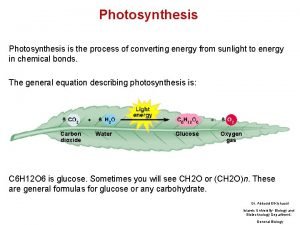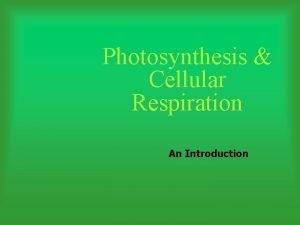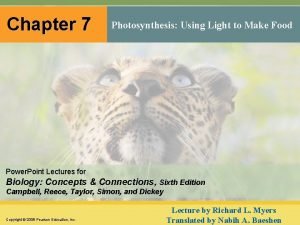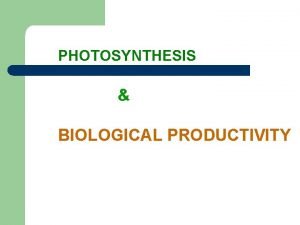The Process of Photosynthesis Things to Learn 1












- Slides: 12

The Process of Photosynthesis Things to Learn: 1) What happens during Light-Dependent Reactions 2) What happens during Light-independent Reactions 3) The Factors that affect Photosynthesis

Membrane • Chloroplast full of membranes • Essential for photosynthesis • Thylakoid Membrane keep + - charges generated by light absorption on opposite sides of the membrane (KEY FACTOR for light-dependent reactions)

Light-Dependent Reactions • Use energy from Sun to convert ADP & NAPD+ into energy and electron carriers ATP and NADPH • Oxygen is a bi-product

Light-Dependent Reactions • Photosystems: clusters of Thylakoids & proteins essential for lightdependent reactions • Light absorbed by chlorophyll molecules in the photosystems is the beginning of the process

Photosystem II • Light dependent reactions begin here • Discovered after photosystem I • Absorb light • Excite molecules • Water molecules torn apart 2 Hydrogen & 1 Oxygen • Oxygen released to air

Electron Transport Chain • Electrons move along the transport chain • Energy used by proteins to pump more stroma

Photosystem I • Energy has been lost since photo II • Pigments in photo I use light to reenergize • Pass electrons to electron carrier (NADP+) • Stroma pick up these electron & combine w/ H+ ions to become NADPH

Hydrogen Ion movement & ATP Formation • During Photo II: Hydrogen ions split H 2 O • Some Hydrogen ions remain to provide energy for ATP • ATP synthesis: protein that spans the membrane & allows H+ ions to pass through it (combine ADP & phosphate = ATP)

Light-Independent Reactions (CALVINS CYCLE) • Use energy from ATP & NADPH (from light-dep. Reac. ) to synthesize stable high-energy sugars (pg. 295) • Carbon Dioxide enters cycle • During cycle 2 of 12 3 -Carbon molecules are removed & contribute to plant metabolism • Remaining 10 3 -Carbon return for next Calvin Cycle This Photo by Unknown Author is licensed under CC BY-SA-NC

Factors Affecting Photosynthesis • Temperature: best 0 – 35 degrees Celsius • Light intensity: higher intensity = increases rate of photosynthesis • Water: shortage of water can stop photosynthesis

Photosynthesis under extreme conditions • In times of water shortage, plants close small openings in leaves • Reduces water loss, reduces Carbon Dioxide intake • Plants that adapt • C 4: capture low level of CO 2 • CAM: capture CO 2 at night

Key Topics 1) Analyze the information & graph on page 296(Analyze Data), answer questions 1 to 3 2) How do the compounds of ATP & NADPH result from the Sun’s energy during photosynthesis? 3) At what point does “food” for the plant result from photosynthesis? 4) Compare & contrast Light-dependent & Light-independent reactions 5) Explain the series of events that the Electron Transport Chain goes through as it proceeds from Photosystem II to Photosystem I 6) What are the main products of the Carbon Cycle? 7) Where do Light-independent reactions occur?
 Kinesthetic learner
Kinesthetic learner 6 life lessons you can learn from an ant.
6 life lessons you can learn from an ant. What food do plants make
What food do plants make The process of photosynthesis and cellular respiration
The process of photosynthesis and cellular respiration Photosynthesis is the process of converting
Photosynthesis is the process of converting The chemical process of photosynthesis
The chemical process of photosynthesis The process of photosynthesis
The process of photosynthesis Equation of photosynthesis process
Equation of photosynthesis process Pyramid hesd
Pyramid hesd Living things life processes
Living things life processes Hát kết hợp bộ gõ cơ thể
Hát kết hợp bộ gõ cơ thể Bổ thể
Bổ thể





















